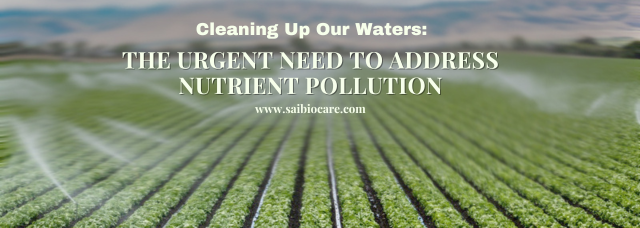
Agriculture is essential for food production, but it also presents environmental challenges, particularly nutrient pollution. This form of water pollution, resulting mainly from the use of fertilizers and livestock waste, can significantly impact ecosystems, water quality, and even human health. Understanding the causes and consequences of nutrient pollution in agricultural water is essential for creating effective, sustainable solutions.
What is Nutrient Pollution?
Nutrient pollution occurs when excess nitrogen and phosphorus from agricultural sources seep into water bodies, disrupting natural balances. These nutrients are critical for plant growth but, in excessive amounts, lead to water pollution. The result can be damaging not only to aquatic ecosystems but also to the surrounding environment.
Causes of Nutrient Pollution in Agriculture:
- Fertilizer Runoff –
Farmers use nitrogen- and phosphorus-rich fertilizers to enhance crop yields. However, rain or irrigation can wash excess fertilizers from fields into nearby streams, rivers, and lakes. These nutrients then travel through watersheds, causing pollution in larger bodies of water. - Animal Waste –
Livestock produces significant amounts of waste, which contains high levels of nitrogen and phosphorus. When not managed properly, these nutrients can enter water sources, especially during heavy rains or flooding, causing pollution downstream. - Erosion and Soil Degradation –
Intensive farming can lead to soil erosion, stripping the land of topsoil and its attached nutrients. When soil erodes, the nutrients bonded to it are transported into water bodies, contributing to pollution. - Excessive Irrigation –
Over-irrigating farmland can lead to the leaching of nutrients into groundwater and surface waters. Water-soluble nitrogen, for example, easily dissolves and is carried through the soil, polluting nearby waterways.
Consequences of Nutrient Pollution in Agricultural Water:
- Algal Blooms & Hypoxia – Excess nutrients lead to algal blooms that block sunlight and deplete oxygen, creating “dead zones” where aquatic life cannot survive.
- Ecosystem Harm – Disrupted aquatic ecosystems harm fish, plants, and biodiversity due to reduced oxygen and unbalanced nutrient levels.
- Human Health Risks – Toxins from algal blooms and high nitrate levels in drinking water can cause respiratory issues, skin irritation, and serious health problems.
- Economic Impact – Polluted waters harm fisheries, tourism, and recreational activities, increasing water treatment costs and impacting local economies.
Solutions to Mitigate Nutrient Pollution:
- Precision Agriculture
By applying fertilizers only where and when they are needed, precision agriculture minimizes nutrient runoff. Techniques include using GPS technology, soil sensors, and variable-rate fertilization, all of which reduce excess nutrient application and its harmful effects. - Buffer Strips and Wetlands
Planting vegetation along waterways can trap nutrients before they enter water bodies. Wetlands serve a similar function by filtering water and absorbing nutrients. Both methods create a natural barrier, reducing nutrient pollution from agricultural lands. - Efficient Irrigation Systems
Using drip or controlled irrigation systems reduces runoff by applying water directly to the plants, minimizing excess water and nutrient movement. - Cover Crops
Planting cover crops, such as clover or rye, during the off-season helps retain nutrients in the soil and prevents erosion. These crops act as a natural fertilizer, reducing the need for synthetic applications. - Responsible Livestock Management
Proper waste management techniques for livestock can prevent nutrients from entering water systems. For example, constructing barriers around livestock areas, composting waste, and storing manure safely can reduce the risk of nutrient pollution.
Conclusion
Nutrient pollution in agricultural water is a complex issue with significant environmental, health, and economic implications. By understanding the causes and effects, farmers, policymakers, and communities can work together to implement sustainable agricultural practices that protect water quality. Balancing food production with environmental preservation is essential for a healthy and sustainable future.
